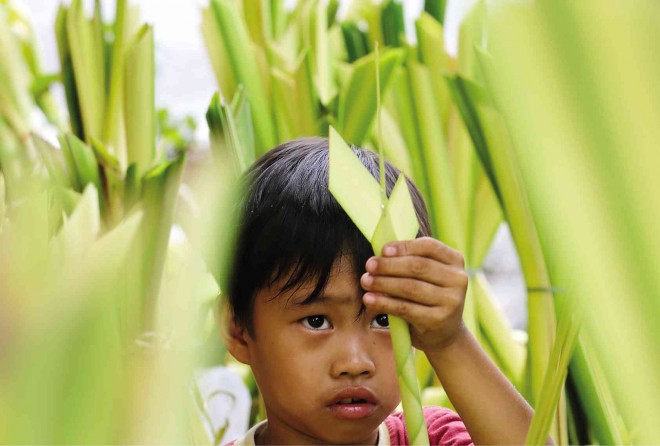
ARTISTIC TRADITION Kim Xymon Bautista, 7, of Famy, Laguna province, helps his family in the weaving of palm fronds that will sell for P15 apiece outside Sto. Domingo Church in Quezon City, for the celebration of Palm Sunday today, the beginning of Holy Week. The palm frond is a symbol of victory and peace. RAFFY LERMA
Palm Sunday marks the beginning of Holy Week, also called Passion Week, the most solemn and intense period of worship in the Christian world. This culminates in the celebration of Christ’s resurrection on Easter Sunday, the cornerstone of the Christian faith.
The Gospel of the Passion of Christ (Mark 14:1-15:47) is read in today’s Mass. (It is reread the second time on Good Friday.) It tells the story of Jesus’ last supper with his disciples, the agony of Jesus in the Garden of Gethsemane, the betrayal of Judas and the arrest, trial, crucifixion, death and burial of Jesus.
Tying the three other readings in today’s Mass, we find the common themes of suffering and obedience.
The first reading (Isaiah 50:4-7) is about the submissiveness of the suffering servant to his persecutors. The psalm (Psalm 22) is a prayer of a man of God suffering from persecution. The second reading (Philippians 2:6-11) is about the suffering of Christ in humble obedience.
Suffering in Gethsemane
Reflecting on these themes, we can contemplate on the story of Jesus praying at the Garden of Gethsemane (Mark 14:32-42). Gethsemane is the garden where Jesus and his disciples went after having supper on the eve of Jesus’ crucifixion. Located at the foot of the Mount of Olives, it is known as the place where Jesus agonized and prayed while his disciples slept.
The brief passage is rich in intertextual echoes of the Hebrew Scriptures as it continues the pervasive motif in the preceding verses, in which Jesus predicts that Peter would deny knowledge of him and his suffering and abandonment by his followers during a time of trial (Job 19:13-22; Psalm 41:8-10; 55:12-14; Zechariah 13:5-7).
In the account, Jesus told Peter, James and John: “My soul is sorrowful even to death.” These words of Jesus reflect Psalms 42:5, 11; 43:5, “My soul is cast down within me.” Jesus is the innocent sufferer who speaks in the language of the lament psalms (see also Psalms 31:10-11;55:5).
Metaphor of the cup
The phrase “unto death” suggests that Jesus’ sorrow is so intense that it threatens his life, echoing Sirach 37:2, “Is it not a sorrow like that for death itself when a dear friend turns into an enemy?”
Full of distress, Jesus prays that God spare him of the sufferings awaiting him, “Abba, Father … Take this cup away from me.” In the Hebrew Scriptures, the “cup” image is often used by the prophets to describe the suffering that God will bring on the enemies of God’s people (Isaiah 51:17 and Jeremiah 25:15).
Jesus prayer about this “cup” should be read in the light of his challenge to James and John to “drink the cup that I drink” (Mark 10:38-39) and his words over the cup at the Last Supper (“my blood of the covenant poured out for many”). In these cases, the metaphor of the cup refers to the suffering of Jesus.
At the end of his prayer, Jesus affirms his faith in God’s power and submits to his will. This prayer of God’s will to be done and Jesus addressing God as “Abba, Father” are noted as links of the Gethsemane narrative to the Lord’s Prayer. Since the Lord’s Prayer is a prayer for the full coming of God’s kingdom (“Thy kingdom come”), these echoes are said to indicate an eschatological mood of the Gethsemane account.
Three times Jesus leaves his disciples to pray and return to find them sleeping. But in spite of the disciples’ persistent weakness and failures, Jesus invites them to accompany him as he moves forward to the cross. (“Get up. Let us go.”)
We may be human and weak, but we are invited to suffer for Christ and to hope in the coming of the kingdom.
Bibliography: Harrington and Donahue, Sacra Pagina: The Gospel of Mark (Minnesota, 2002); Almazan, OFM, “Welcome to Our Bible Study: Passion Sunday B” (unpublished)
(Editor’s Note: The teaching commentary is sourced from Bat Kol Institute at https://www.batkol.info/wp-content/uploads/2015/03/PalmSunday-March-29-2015-final.pdf. The Jerusalem-based institute offers courses for Christians to study the Bible within its Jewish milieu and using Jewish sources. Minerva Generalao heads Inquirer Research and is a Bat Kol Alumna [July 2014].)
RELATED STORIES
Weaving ‘palaspas’ a tradition kept alive in Tayabas City